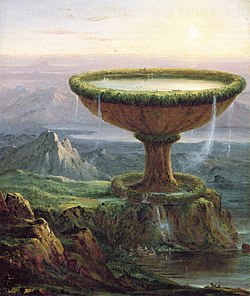| The Titan's Goblet | |
|---|---|
 | |
| Artist | Thomas Cole |
| Year | 1833 |
| Medium | Oil on canvas |
| Dimensions | 49.2 cm × 41 cm (19+3⁄8 in × 16+1⁄8 in) |
| Location | Metropolitan Museum of Art, New York |
| Accession | 04.29.2 |


The Titan's Goblet is an oil painting by the English-born American landscape artist Thomas Cole. Painted in 1833, it is perhaps the most enigmatic of Cole's allegorical or imaginary landscape scenes. It is a work that "defies full explanation", according to the Metropolitan Museum of Art.[2] The Titan's Goblet has been called a "picture within a picture" and a "landscape within a landscape": the goblet stands on conventional terrain, but its inhabitants live along its rim in a world all their own. Vegetation covers the entire brim, broken only by two tiny buildings, a Greek temple and an Italian palace. The vast waters are dotted with sailing vessels. Where the water spills upon the ground below, grass and a more rudimentary civilization spring up.
- ^ "Yggdrasil: The Sacred Ash Tree of Norse Mythology". The Public Domain Review.
- ^ The Titan's Goblet. Collections Database, Metropolitan Museum of Art. Accessed August 14, 2010.